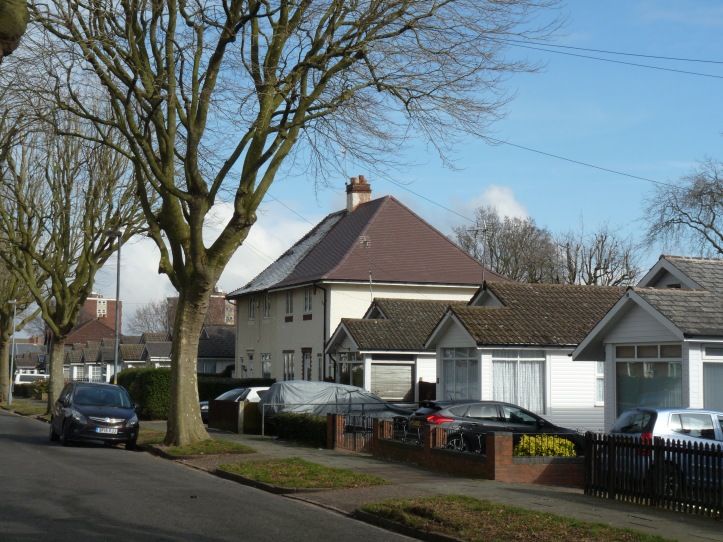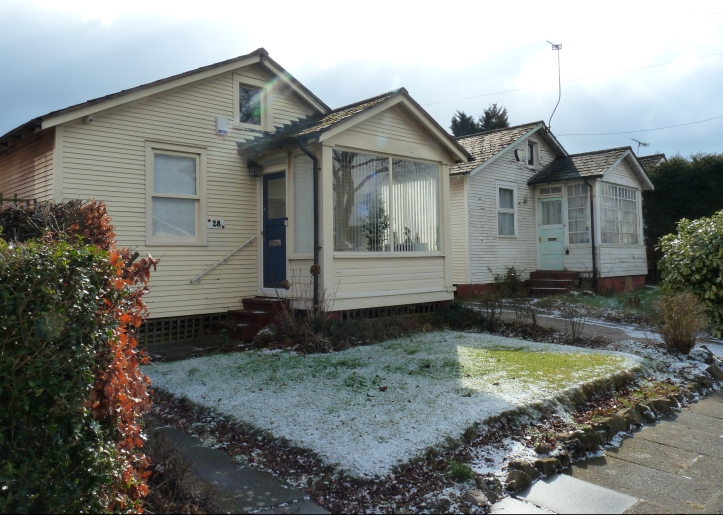Austin Village is one of only 11 conservation areas in Birmingham covered by Article 4 Direction (I mostly just want to write about my interesting day out and not planning regulations, but more details about what Article 4 is can be found here!) Essentially what this means is that it is a residential area which has been deemed to have special architectural or historic interest which limits the type of modifications can be made to existing buildings and places restrictions on new developments.

Austin Village is in South Birmingham between Northfield and Longbridge train stations, it was built by Herbert Austin in 1917 to house workers from his factory which had grown because of war production. The single-story cedar wood bungalows were imported from the US and this gives the estate a very North American feel even now that they are surrounded by high-rise buildings and more traditional English homes. At the time these homes were state-of-the-art with gas cookers and water boilers and even though they were constructed as pre-fabs there was a maintenance plan for painting the exterior. The cedar wood houses were interspersed with brick ‘fire-break’ houses (pictured below).

There is one main ‘boulevard’ Central Avenue which runs down the middle of the estate but many of the streets were planted with mature trees many of which are still there today. This estate (unsurprisingly since it was built by a car manufacturer) was obviously designed to try and balance the needs of drivers and pedestrians.

It was designated as a conservation area in 1997 but recently there have been discussions about whether the percentage of properties that have been significantly changed mean that this designation will be removed.
Austin Village is an interesting place (and definitely worth a visit if you’re in the area on a sunny day!) but mostly, to me it raised a lot of questions about the role and value of conservation areas, especially in Birmingham which has very limited resources in their conservation department. Residential areas are particularly interesting because their architectural and aesthetic merits often rely on uniformity rather than stand-alone buildings.

This aspect of residential conservation areas means that even relatively minor changes really impact on the feel of the streets. Lots of the houses here have plastic cladding and windows and some have even more dramatic changes. I’m sure that most of these amendments improve the livability of these homes but there is no doubt that they impact on the significance of the area as a whole and the overall aesthetic significance. However, should this be a primary concern when these houses need to function firstly as places to live?
Austin Village bungalows- photo by @katfakts February 2018
I live in nearby Stirchley which is next to Bournville Village conservation area a markedly different place to Austin Village, althought it was built as a workers’ village by the Cadbury family it is now an affluent area comprised of large, desirable family homes.
Historic photos of Bournville- image from Birmingham Post
The area is overseen by Bournville Village Trust and they provide lots of excellent resources for homeowners such as a detailed design guide about different types amendments/ improvements that can be done and how work should be carried out. In smaller or less prestigious residential conservation areas, especially those with non-traditional building materials this information is harder to come by. There is no style guide for residents of Austin Village and the Austin Village Preservation Society is run by volunteers. This means that even residents who want to maintain their houses correctly, or make necessary improvements (for example when windows need replacing) don’t know what they should be doing. If resources aren’t easily and readily available, is it really reasonable to expect residents to hunt out this information when any changes that they make aren’t being policed.

There is also much less of a financial incentives to maintain lower income properties in a way that is in-keeping. In Austin Village the bungalows were pre-fabricated and weren’t designed to still be there 100 years after they were built which makes things like insurance and mortgage provision complicated. So many of the houses which a conservation officer would find shocking (those clad in uPVC or with changes to the windows) are well maintained and cared for in a way that some of the more traditional properties aren’t.
This begs the question of whether we should be reassessing how we think about twentieth century conservation areas. Should we care more about the sense of place and the sense of community that certain types of houses and estates can bring about? Should we accept that in order to make properties such as these continue to be viable houses, changes have to be made and if these changes are within the spirit of the original development that is a good compromise? For example cladding in a different material might be acceptable, where changing the shape or the height of a building might not.

In order for residential conservation areas to thrive, the residents need to not only buy into the idea that they are living in an important, historic place but to also get something out of it. This could be a sense of community/ pride in where they live, but there are also practical considerations such as the financial ability to make changes correctly, and the availability of advice.

Ampersand Projects are working on the Heritage Lottery Fund supported ‘Built to Last: Austin Village at 100′ project which is looking at the history of the village with a focus on the experiences and memories of the current residents. Matt Andrews from Ampersand Projects said, “One interesting point that’s come out of our interviews is that until relatively recently (1990s perhaps), it wasn’t necessarily thought of being a special place. They were built to fulfil the short-term shortage of housing and they’ve long outlived their 15 year lifespan.” He went on to say that residents feel that they haven’t really had guidance about how they can modify their homes to make them livable while preserving the character. Matt went on to say that the biggest concern that residents have voiced is that the removal of conservation area would mean that the houses will get bought up, knocked down and replaced with new buildings. It will be interesting to see the outcome of this project and how it contributes to the discussions about Austin Village potentially losing its conservation area status.
Austin Village bungalows- photo by @katfakts February 2018
This post is largely just a series of questions with no answers, but this is a complicated issue which is currently receiving a lot of attention within the conservation community. Hopefully events such as the Twentieth Century Society’s ‘C20 Conservation Areas: Making it Happen‘ and the publication of their research on this topic will address a lot of these issues and continue to spark debate about what conservation should be and what we value in our build environment.













Its clear BCC have failed miserably not only here but in several CA’s. No guidance, no policing, no enforcement has resulted in the rapid deterioration of many CA’s. As to maintenance well I do not think its a case of too little money (or credit?) to maintain the properties, there has clearly been plenty of money spent, but unfortunately not in keeping with their character, ok that’s again is back to BCC failures as mentioned earlier.
LikeLike